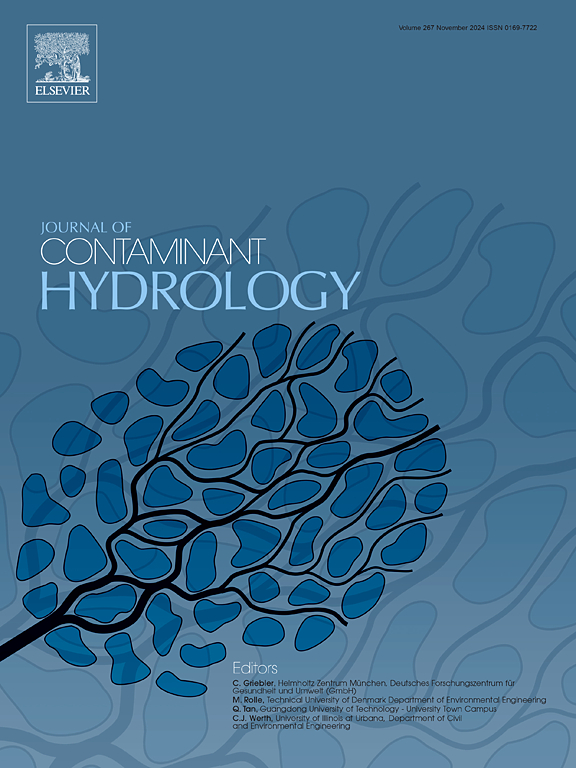Effects of pH, ionic strength, and temperature on Cs, Ba, Co, and Eu sorption onto biotite: A combined experimental and modeling study
IF 3.5
3区 环境科学与生态学
Q2 ENVIRONMENTAL SCIENCES
引用次数: 0
Abstract
The trace metal sorption onto the phyllosilicate mineral biotite, commonly found in granitic rock, has been studied with batch sorption experiments that were carried out for up to two months. The aim was to investigate the uptake mechanism of the radioisotopes 134Cs, 133Ba, 60Co, and 152Eu at trace concentrations (10−8 M) onto crushed biotite at a particle size 0.25–0.5 mm. under inert gas conditions ([O2] < 1 ppm) and to provide data for a Surface Complexation Model. The experiments were conducted in triplicates with the pH adjusted to 5, 6, 7, 8, or 9 with pH-buffered solutions containing either 0.001, 0.01, or 0.1 M NaClO4 at two temperatures: 40 and 60 °C. The results show that the sorption of Cs, Ba, Co and Eu onto biotite are strongly pH-dependent where each element shows a characteristic uptake behavior. The sorption of Cs and Ba appear to be particularly sensitive to increased ionic strength which decreases their sorption while Eu is less affected. In contrast, Co sorption seems to be largely non-affected by change of ionic strength. A temperature increase, on the other hand, has a positive effect on sorption for almost all elements. To estimate the surface acidity constants (pKa) of biotite at 40 and 60 °C, titration experiments were performed with biotite suspended in solution over a pH range of approximately 3–11. Modeling of the titration data resulted in pKa,1 = −5.0 ± 0.2 at 40 °C and 5.3 ± 0.2 at 60 °C. Similarly, pKa,2 = −7.0 ± 0.3 at 40 °C and–6.9 ± 0.2 at 60 °C. The sorption data (Rd values) of all metals was successfully modelled with a combination of one amphoteric (2-pKa) surface complexation site and one ion-exchange site. A non-electrostatic SCM, without any compensation for surface electrostatic effects from electrolyte solution, were used with the reaction constants and coefficients as fitting parameters. From these, the thermodynamic parameters and for the sorption reactions were calculated. The results show that surface- complexation reactions are primarily entropy-driven, while ion-exchange reactions are enthalpy-driven.
pH、离子强度和温度对Cs、Ba、Co和Eu在黑云母上吸附的影响:一项实验和模型联合研究
通常在花岗质岩石中发现的层状硅酸盐矿物黑云母上的微量金属吸附,已经通过进行了长达两个月的批量吸附实验进行了研究。目的是研究放射性同位素134Cs、133Ba、60Co和152Eu在微量浓度(10−8 M)下,在惰性气体条件([O2] <;1 ppm),并为表面络合模型提供数据。实验分三次进行,pH值调整为5、6、7、8或9,pH缓冲溶液中含有0.001、0.01或0.1 M NaClO4,温度分别为40和60°C。结果表明,Cs、Ba、Co和Eu在黑云母上的吸附具有很强的ph依赖性,每种元素都表现出特有的吸附行为。Cs和Ba的吸附对离子强度的增加特别敏感,离子强度的增加会降低它们的吸附,而Eu对离子强度的影响较小。相反,Co的吸附似乎基本上不受离子强度变化的影响。另一方面,温度升高对几乎所有元素的吸附都有积极的影响。为了估算黑云母在40°C和60°C时的表面酸度常数(pKa),我们将黑云母悬浮在pH范围约为3-11的溶液中进行了滴定实验。对滴定数据进行建模得到pKa,在40°C时为- 5.0±0.2,在60°C时为5.3±0.2。同样,pKa, 2 =−7.0±0.3在40°C和- 6.9±0.2 60°C。用一个两性(2-pKa)表面络合位和一个离子交换位的组合成功地模拟了所有金属的吸附数据(Rd值)。采用不补偿电解液表面静电效应的非静电单片机,以反应常数和系数为拟合参数。由此计算了吸附反应的热力学参数∆H和∆s。结果表明,表面络合反应以熵驱动为主,而离子交换反应以焓驱动为主。
本文章由计算机程序翻译,如有差异,请以英文原文为准。
求助全文
约1分钟内获得全文
求助全文
来源期刊

Journal of contaminant hydrology
环境科学-地球科学综合
CiteScore
6.80
自引率
2.80%
发文量
129
审稿时长
68 days
期刊介绍:
The Journal of Contaminant Hydrology is an international journal publishing scientific articles pertaining to the contamination of subsurface water resources. Emphasis is placed on investigations of the physical, chemical, and biological processes influencing the behavior and fate of organic and inorganic contaminants in the unsaturated (vadose) and saturated (groundwater) zones, as well as at groundwater-surface water interfaces. The ecological impacts of contaminants transported both from and to aquifers are of interest. Articles on contamination of surface water only, without a link to groundwater, are out of the scope. Broad latitude is allowed in identifying contaminants of interest, and include legacy and emerging pollutants, nutrients, nanoparticles, pathogenic microorganisms (e.g., bacteria, viruses, protozoa), microplastics, and various constituents associated with energy production (e.g., methane, carbon dioxide, hydrogen sulfide).
The journal''s scope embraces a wide range of topics including: experimental investigations of contaminant sorption, diffusion, transformation, volatilization and transport in the surface and subsurface; characterization of soil and aquifer properties only as they influence contaminant behavior; development and testing of mathematical models of contaminant behaviour; innovative techniques for restoration of contaminated sites; development of new tools or techniques for monitoring the extent of soil and groundwater contamination; transformation of contaminants in the hyporheic zone; effects of contaminants traversing the hyporheic zone on surface water and groundwater ecosystems; subsurface carbon sequestration and/or turnover; and migration of fluids associated with energy production into groundwater.
 求助内容:
求助内容: 应助结果提醒方式:
应助结果提醒方式:


